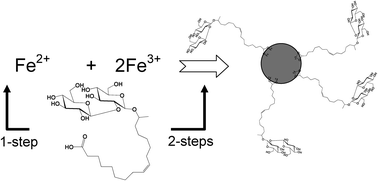Sophorolipids-functionalized iron oxide nanoparticles†
Abstract
Functional

* Corresponding authors
a
UPMC Univ Paris 06, UMR 7574, Chimie de la Matière Condensée de Paris, Paris, France
E-mail:
niki.baccile@upmc.fr
b CNRS, UMR 7574, Chimie de la Matière Condensée de Paris, Paris, France
c Collège de France, UMR 7574, Chimie de la Matière Condensée de Paris, Paris, France
d Institut Charles Gerhardt Montpellier – AIME, UMR5253, Université Montpellier II, CC. 1502, Place E. Bataillon, Montpellier cedex 5, France
e InBio, Department of Biochemical and Microbial Technology, Faculty of Bioscience Engineering, Ghent University, Coupure Links 653, Ghent, Belgium
Functional

 Please wait while we load your content...
Something went wrong. Try again?
Please wait while we load your content...
Something went wrong. Try again?
N. Baccile, R. Noiville, L. Stievano and I. V. Bogaert, Phys. Chem. Chem. Phys., 2013, 15, 1606 DOI: 10.1039/C2CP41977G
To request permission to reproduce material from this article, please go to the Copyright Clearance Center request page.
If you are an author contributing to an RSC publication, you do not need to request permission provided correct acknowledgement is given.
If you are the author of this article, you do not need to request permission to reproduce figures and diagrams provided correct acknowledgement is given. If you want to reproduce the whole article in a third-party publication (excluding your thesis/dissertation for which permission is not required) please go to the Copyright Clearance Center request page.
Read more about how to correctly acknowledge RSC content.
 Fetching data from CrossRef.
Fetching data from CrossRef.
This may take some time to load.
Loading related content
